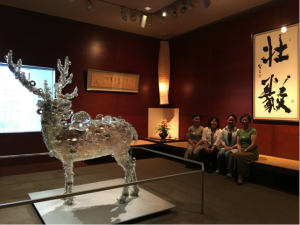This summer I worked with Professor Peipei Qiu on Environmentalism in Japan, a project jointly carried out with Professor Hiromi Dollase and Ford Scholar Xiaoting Hu in the Chinese and Japanese Department. My work was primarily to compile materials to be used for the third-year Japanese course in the spring of 2019, incorporating the study of environmental issues in Japan into language learning. At the third-year level students still need to learn Japanese grammar by using a textbook, therefore our project is to add a research component to have the students examine Japan’s environmental issues through a digital story telling assignment.
In preparing the teaching materials, we divided the environmental issues into the following areas: air pollution, water pollution, earth erosion and forest preservation, endangered species, nuclear radiation, natural disasters, environmental policy and environmental activism, human-environment interaction, waste management, and energy saving. Students would need to select a topic from one of the areas above and create a story in Japanese based on their research and make a digital presentation.
During the first days we compiled thematic bibliographies of books, articles, videos, and images for each category, so that students can have an informed starting point for research. In order to make sure that our sources are comprehensive with diverse genres, we took two trips to New York City, collecting materials from Japanese bookstores and watching relevant play and artistic exhibitions. We watched Time’s Journey Through a Room, an English adaption of a Japanese play by Toshiki Okada. It is a non-linear narrative of how the 2011 Tohoku earthquake and tsunami changed people’s lives. We also visited the Metropolitan to see the exhibition “The Poetry of Nature: Edo Paintings from the Fishbein-Bender Collection.” These activities deepened our understanding of the tradition and current conditions of Japan’s environment.
The project team at the Japanese art exhibition
Towards the end of the project I helped Professor Qiu prepare reading and listening comprehension materials on environmental issues, and also learned how to use Final Cut Pro to create digital stories. These tasks required me to use Japanese language extensively and learn how to use a digital editing tool. As a follow-up activity of the Ford Scholars Project I will use both my language and computer skills to help the students in Japanese 306 to create their digital stories.
One of the highlights of our research activities was an interview of Mrs. Tomiko West, the founding member of Vassar’s Japanese program and an atomic bomb survivor. She survived the Hiroshima atomic bombing at the tender age of thirteen. It was poignant to hear her personal experience of the nuclear bombing, radiation, and black rain. The horrifying images of nuclear catastrophe and radioactive diseases took concrete shape in the abrupt deaths of her parents and grandparents. With a video camera we recorded her testimony on the catastrophic impact of nuclear weapon and her statement calling for world peace and environment protection. These recordings will be preserved in Vassar’s Chinese and Japanese Department as powerful educational materials for generations to come. The interview with Mrs. West was an unforgettable moment when the traumatic events that seem so far away actually intersect with our lives in the Vassar community.
Mrs. West telling us her experience during the Hiroshima atomic bombing.
The ultimate goal of this Ford project is to help students in Japanese classes realize how environmental issues are both local and global, thereby cultivate a sense of personal responsibility.


